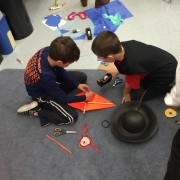This lesson is for : Grade 3:
Summary
Angles, angles everywhere! After learning about lines, angles and rays in our recent geometry unit, students completed a scavenger hunt in our classroom to see real world examples. The students found many geometrical lines on the floor, on the walls and even on the ceiling. They were able to point out different angles that were being formed by doors and windows right here in our classroom. After our scavenger hunt, we brainstormed where we see angles in the world around us. Students thought of many ideas including roads, railroad tracks, buildings, bookshelves, windows, clocks, sailboats, umbrellas, and kites. We decided that kites used many different angles and were ready to learn more. After researching what makes a strong kite using OneSearch, kidrex.org and/or duckduckgo.com and their planning sheets, students were to design a kite identifying all of the geometric properties. Students worked in pairs to research and design their kites using Doodle Buddy, Google Drawing or Pixie. Once complete, students submitted their work and uploaded it to their google drives along with their research and planning sheet. Students were given two weeks to construct their kites at home using everyday materials. Students then brought their projects in to “test out” outdoors. Each group shared their kites with the class. Presentations were filmed by students using the ipads. Using the app, VivaVideo, the presentation videos were edited and uploaded to our class blog to share with parents and other classes where they had the opportunity to comment on each other’s hard work. Students filled out a digital reflection form evaluating their teamwork and thought about what they might do differently next time.
TIPC Ratings
Research & Information Fluency
Rating: Ideal – Explanation: Students chose a kid-friendly search engine to research and synthesize information to address the authentic task of creating a kite that will fly that incorporates all of the geometry terms in the design. Afterwards, students displayed and interacted with the information they discovered as they invented and constructed a kite using everyday items.
Communication & Collaboration
Rating: Ideal – Explanation: Communication and collaboration occurred during the design process. Students were given the option to work together or individually outside of school or work to construct their kite. The class worked together to share out their kite structures by presenting to the other third grade classes and posting pictures of the projects on our classroom blog. Students had the opportunity to comment on each other’s projects on our classroom blog.
Critical Thinking & Problem Solving
Rating: Ideal – Explanation: Critical thinking and problem solving were exercised throughout this lesson. Students had to be innovative as they researched, designed and constructed a kite that included all essential geometry vocabulary in the design. They also had to choose the best digital tool that would illustrate their idea. The reflection helped students reflect on their roles as critical thinkers and problem solvers.
Creativity & Innovation
Rating: Ideal – Explanation: Students had to synthesize existing and self-generated knowledge about kite construction and geometry during the research component and then had to collectively invent a kite that would fly when tested. Not only did students have to come up with an innovative idea, they had to carry it out by creating a kite structure using everyday items. Their kites were presented to the community using the class blog.






